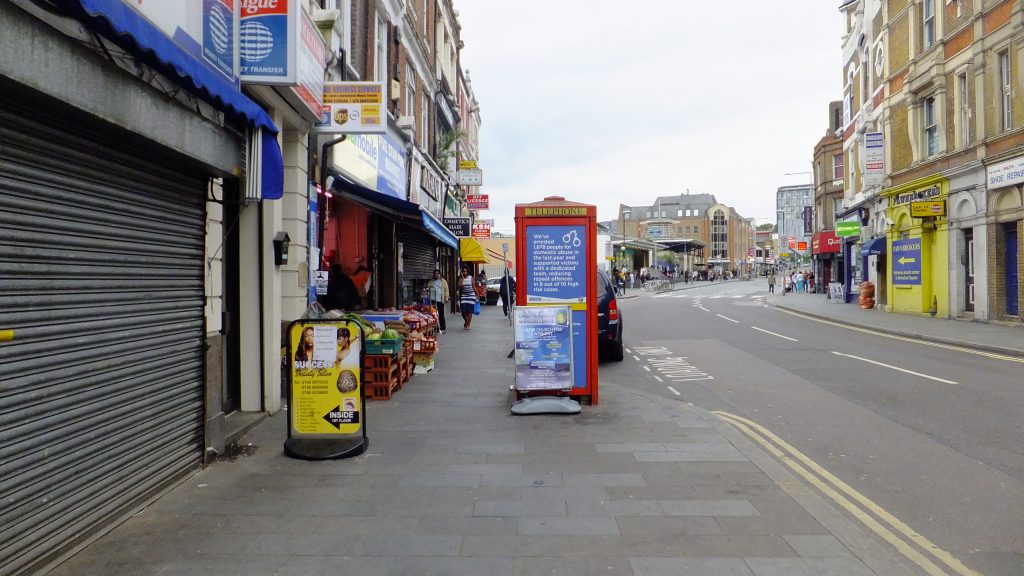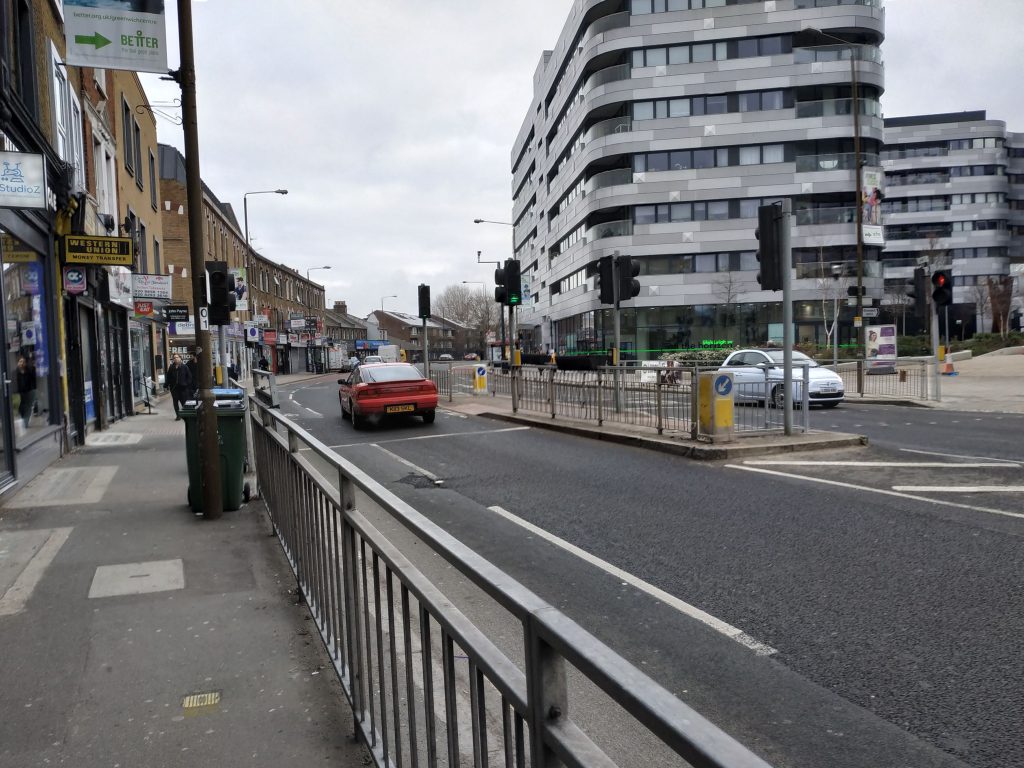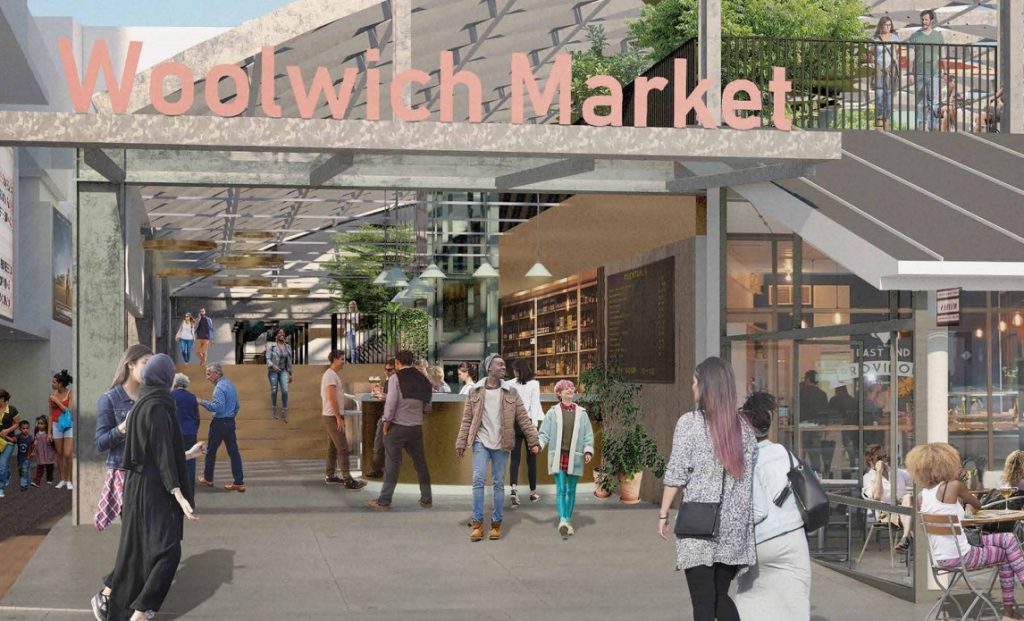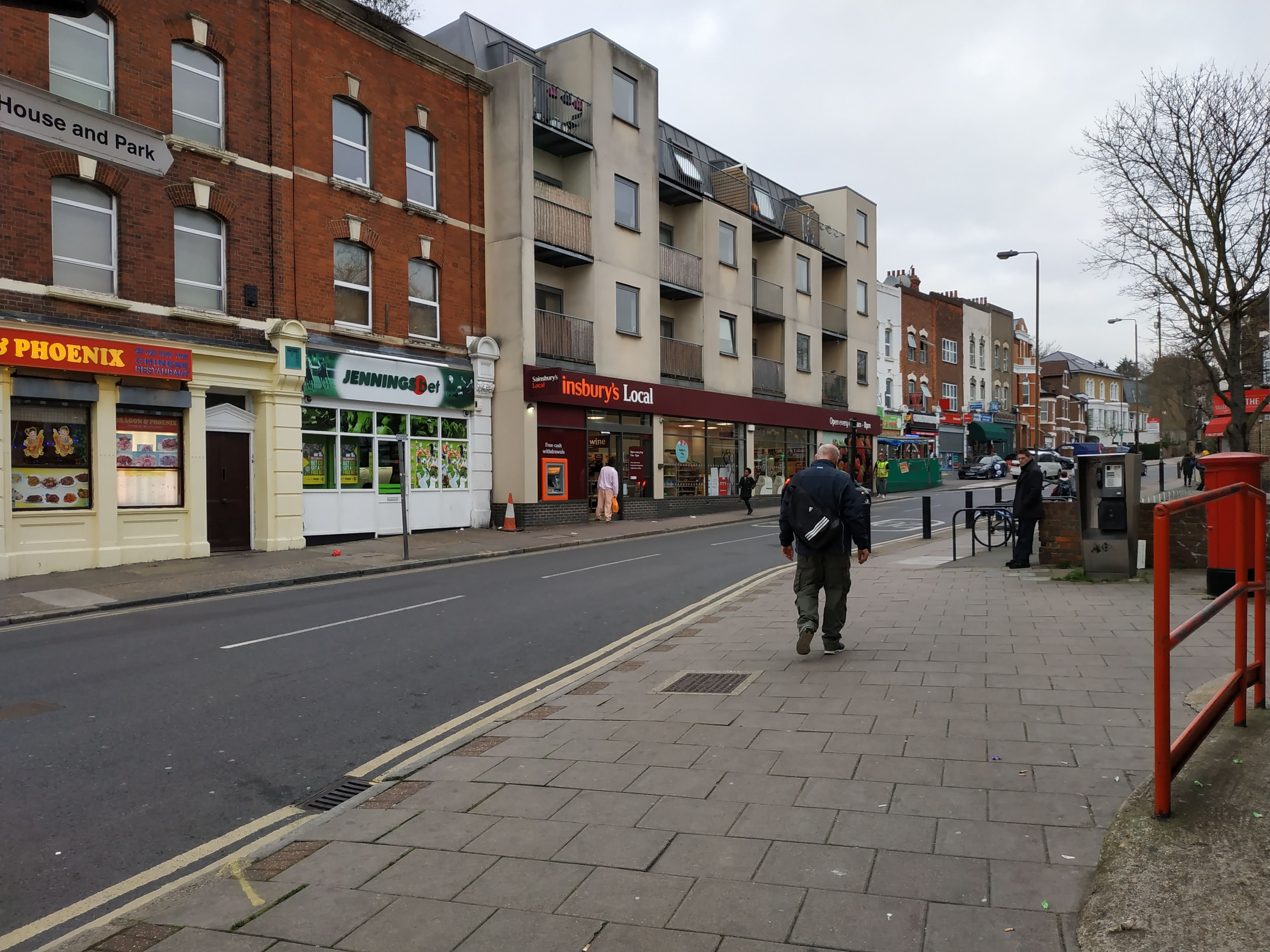Narrow paving, cramped streets and social distancing in London
In recent weeks cities the world over have begun to dedicate greater amounts of street space to pedestrians as a result of social distancing. London and other UK cities have been conspicuous in not doing so.

This is often due to a convoluted mess of who manages streets. There’s a lack of strategic overview and planning. The current situation simply exacerbates long-standing problems of pedestrians long thought of as an afterthought and wedged into narrow spaces – which excessive street clutter exacerbates further.

When thing return to normal the issue of limited space for those on foot will remain. In many cases, it will increase. With the current situation merely highlighting existing problems, let’s look at some planned developments which will increase problems rather than improve the situation.
Woolwich
A major development planned at the current Woolwich market pound which was submitted last year doesn’t plan to leave much space for paving alongside a busy road.

Here’s a closer look. There’s so little apparent space between tnew buildings and the kerb that a segregated cycle lane cannot be accommodated, and so they will still dice with traffic and buses pulling into stops.

Next up is another Woolwich site just east named Woolwich Exchange a.k.a Spray Street. These are revised plans revealed earlier this year:

The area currently has ample pedestrian space. Perhaps not for long?

The market is now listed and will be retained and extended onto the street if plans approved. This is another busy area comprising bus stops, shops and in future towers including hundreds of homes.

New Cross
Recent plans for new flats at Achilles Street in an area of high footfall beside New Cross station, shops and bus stops again shows pavement space narrowed.

Somewhat unusually in London there’s currently ample space for those on foot. This is a legacy of post-war design which sought to increase space for pedestrians. That now looks to be removed:

Lewisham
A new building featuring shops and a Travelodge hotel in Lewisham currently rising doesn’t leave much space:

For busy areas in major town centres pavement space is often pitiful in London. Far, far less than would be seen in many European and north American city centres where wide avenues are the norm.

There was no Haussmann in London as in Paris, no Eixample district as seen in Barcelona which was designed by Ildefons Cerdà, no Hoddle Grid as in Melbourne (though those designs are not without problems) and it’s not easy to rectify medieval streets but many new-builds do very little to improve streets particularly alongside roads, or even take it away revealing the relative unimportance of pedestrians in London and the UK.
Charlton
There’s ample examples of recent developments depriving pedestrians of space. A block opposite Charlton station containing Sainsbury’s juts out from the street building line leaving a narrow strip of paving despite being an area of high footfall:

That leaves minimal pedestrian space:

What we continue to see again and again is commercial drive for maximising space taking precedence over pedestrians – and little apparent opposition. I’ve highlighted land grabs in previous posts. I can’t recall many politicians saying a thing.
On top of meagre space allocated to pedestrians we also regularly see street clutter placed onto narrow pedestrian space. Naturally, some authorities are worse than others.

Even during the current lockdown Greenwich Highways are installing more random bollards. The authority is broke, stretched and Highways still can’t resist.

But let’s end on a positive. One such example is Trafalgar Road in Greenwich. Pavement space is extremely limited and made worse by too much clutter. Much have now gone and the street is all the better for it.

Unfortunately only large scale projects seem to feature improvements. Day to day management by Greenwich Highways is still stuck decades in the past.
Yet even on Trafalagar Road the fundamental issue remains. It’s very cramped given the level of pedestrians. What’s the solution here? Be radical and close to general traffic? Or is this as far as it can realistically go?
Running a site alone takes time and a fair bit of money. Adverts are far from enough to cover it and my living costs as a private renter.
You can support me including via Paypal here Another option is via Patreon by clicking here You can also buy me a beer/coffee at Ko-fi here There's also a Facebook page for the site here Many thanks






What ever you do with Trafalgar Road you are going to have to allow for the buses – and the decisions of London Buses on that. There is not really a realistic alternative route for the buses and that has been the problem for at least the last 50 years. I also suspect that some of those pavement frontages are owned by some of the shops – that is certainly true of Woolwich Road –
which might complicate things. But you are right about the problems of different ownership – or rather hierarchy of who gets the final say. TfL at the top of the lst and residents are in many ways at the bottom of the list, but there are also differences of opinion. I have been at meetings – not recently though – where one lot of people want more trees and pedestrian space – and another lot, often very resentful of the first lot and very very angry – want more guard rails and a lot more space for cars.
The set back of post war buildings envisaged road widening and so developments on main roads allowed for this. This land is now being exploited for building development rather than remaining in the public realm for pavements or cycle tracks.
Yep that is very true and most post war development did of course also turn their back on main roads as part of segregated plans with walkways and the like. Extensive blank frontages, walls etc. Not all mind and some did cater well for pedestrians though you’re right that many were short term measures for road schemes.
Pet hates – new builds that build up to the edge of the pavement – meaning that to service the building – the pavement is closed. Bollards on narrow pavements – why? If you have to dodge a badly placed bin, person with pram – you end up stepping around the bollard and onto the road… Then you think oops should have looked.
Given the current circumstances, social distancing is likely to become the norm even after lock down is over. For a long time to come, people will walk in the path of cars to reduce the percieved risk of catching a bout of illness (Coronavirus or otherwise).
I have gone on hour long walks over the last few days and I have found myself walking in the road so as to comply with social distancing rules. This can not be right. Note this is when there is low footfall. Imagine the problems when lock down is over. As indicated by John the pavements are not clear and wont be a place for the pedestrians………….. the roads will be.
This is all at a time the council is supposedly encouraging people to live a more healthier lifestyle…………. Only RBG.
This is a problem everywhere in London? Are there any councils better than RBG?
Yes many when it comes to clutter. Have a look at Southwark and most in central. When TfL wanted to remove huge amounts RBG one of few in London to object
Also recently when TfL asked council for comments about new cycle lanes Greenwich asked for clutter to remain on pavements. Others like Lewisham lobbied for feeder cycle lanes. Guess which won as not basing arguments on 30 year old thinking. Lewisham now the winner.
A bit facetious perhaps but I would like to give a mention to the urban artist who keeps painting out the A and es on the eastern Achilles Street road sign so that it reads Chill Street. Much more apt for the surrounding area.
Love it!
You could reclaim a huge amount of space from residential streets by preventing parking on one side of the road.
Trafalgar Road is stuffed though. Unless it was one way.
and if its one way where do the buses go in the other direction? I was going to add what I have just put on twitter – that as far as I know Greenwich has strong restrictions on pavement clutter and I suspect its because of staff shortages that shops aren’t prosecuted. About 8 years ago there was a crackdown and Council officers were fining shops who put anything at all on the pavement – fruit and veg displays, cafe tables, as well as A boards and the like. Some Woolwich and Trafalgar Road shops own their frontages and they could put what they liked out. Lot of ill feeling about it at the time – with many shops and the local Torys getting up anti-council petitions demanding that they continue to put out what they liked.
All about context isn’t it. Stuff on narrow paving isn’t good. Wide paving is generally ok. A-boards are worse than food items generally. Staff cuts no excuse as so many in Woolwich and what were council employed wardens doing? They’ve now privatised it of course so any fine income wouldn’t come to council coffers.
Just reminded of time RBG recently blocked outside seating for cafe on Powis Street. Their own poor design limits paving space by having large raised planters around trees. Baffling in area of high footfall and trees do not need it there. I think the cafe or coffee shop eventually shut. Will have to look into it as covered a couple of years back
I do think the wider pavement by the covered market needs to remain to allow more people to pass each other and give people some more space. A lot of people wait for buses here too.
I think for many people social distancing will remain for sometime to come as the current covid-19 crisis as really shocked a lot of people and will make more people think twice now when out and about.
Keep safe everyone.
Greenwich Council will claim their ‘visionary’ approach to urban design is the future of social distancing, through the use of:
*Bollards, designed to break up large crowds and groups
* Unpaved areas around Peninsular Park (see Asda car park or similar) designed to restrict large crowds and move people to cars which provide better protection than masks.
* Railings, wrought from artisan grade steel to protect innocent pedestrians in case a Covid-stricken driver loses sudden control of their vehicle
Greenwich Council are also leading the way in social distancing by collecting business rates on closed or empty premises, reducing the financial incentives of the owners to spend money unnecessarily and thus keep them at home.
Agree with you John. Constructing new builds up to the edge of the pavement makes it harder for people to pass each other safely forcing people closer to the roads. Which is an accident waiting to happen. The health and safety of pedestrians must be a top priority at all times.